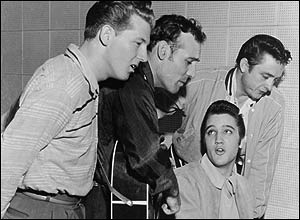 Arkansas-Son Johnny Cash passed away within six months of his equally famous wife, June Carter Cash, on September 12, 2003. This was less than a year before the death of Ray Charles on June 10, 2004. These three deaths in such a short succession represent a significant loss to Americana.
Arkansas-Son Johnny Cash passed away within six months of his equally famous wife, June Carter Cash, on September 12, 2003. This was less than a year before the death of Ray Charles on June 10, 2004. These three deaths in such a short succession represent a significant loss to Americana. In his tribute to Johnny Cash on the artist's death, commentator and VH1 Executive Director Bill Flanagan put forth this wisdom on the CBS program Sunday Morning:
It's becoming more apparent with every year that goes by that the period from the mid-'50s to the mid-'70s was a golden age for popular music. To have lived in the era where Cash and Presley and the Beatles and Stones and Aretha and Dylan and Miles Davis were around is like to have lived in Paris during the time of the impressionists.
That era is moving away. A lot of people have already gone. But you can still go out and buy a ticket and see Dylan and Aretha and James Brown. You can go to a theater or even a club and catch Sonny Rollins and Ray Charles and Little Richard and Jerry Lee Lewis. We can assume that these musicians who loom large in our culture will always be around. They won't. We should appreciate them while we have them because someday we'll turn around and they'll be one.
Mr. Flanagan's list from this magic-painted period has contracted further with the recent deaths of Ray Charles, Nina Simone, Wilson Pickett, Clarence "Gatemouth" Brown, Lou Rawls, Shirley Horn, Percy Heath, Bobby Short, Little Milton, NHOP, Vassar Clements, and RL Burnside. In the shadow of Mr. Flanagan's observations, it is pointedly apparent that while giants still walk the earth, there are fewer and fewer of them. And there are damn few made of the same mettle to stand up and take their place.
Extrapolating from Mr. Flanagan’s tribute, I note that, thankfully, one dynastic clot remains from this ‘Golden Age’ consisting of country cousins: Jerry Lee Lewis, Mickey Gilley, and Jimmy Lee Swaggart. All three remain alive and performing. From their collective meager up-bringing, all three turned into superb singers and pianists, versatile and durable, passionate and contradictory. In the spirit of Bill Flanagan's suggestions and regardless of one's musical predilection, one should make it a point to see these artists if the opportunity arises before they get away from us. So, if one can catch "The Killer" Jerry Lee Lewis performing at his home base of the Hernando Hideaway in North Mississippi, or Mickey Gilley at his Showhouse in Branson, Missouri, or Swaggart when preaching and singing at his home base of Baton Rouge, Louisiana, I suggest he or she does so before the last of the great Sam Phillips Sun years disappears. Three (Cash, Carl Perkins, and Elvis Presley) of the Sam Phillips "Million-Dollar Quartet" are already gone, only The Killer remains.
In the spirit of Bill Flanagan's suggestions and regardless of one's musical predilection, one should make it a point to see these artists if the opportunity arises before they get away from us. So, if one can catch "The Killer" Jerry Lee Lewis performing at his home base of the Hernando Hideaway in North Mississippi, or Mickey Gilley at his Showhouse in Branson, Missouri, or Swaggart when preaching and singing at his home base of Baton Rouge, Louisiana, I suggest he or she does so before the last of the great Sam Phillips Sun years disappears. Three (Cash, Carl Perkins, and Elvis Presley) of the Sam Phillips "Million-Dollar Quartet" are already gone, only The Killer remains.
Our modern concept of “popular music” would be vastly different if the afore mentioned artists had never existed. These giants were responsible for the necessary for the elements of decadence and danger that would flower in the Rolling Stones, The Sex Pistols, 50 Cent. Their mistakes and protest made it possible that there would be The Clash and Green Day. Far from mere nostalgia, a fifty-year-old’s pining away for a new Exile on Main Street, history is finding this musical period and these musical artists to be divinely inspired as opposed to a passing fad.
© Copyright, C. Michael Bailey, 2006
